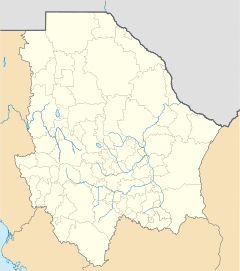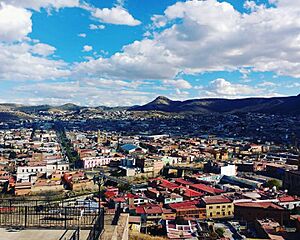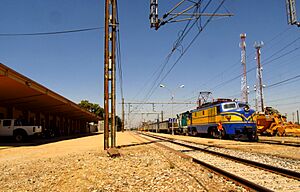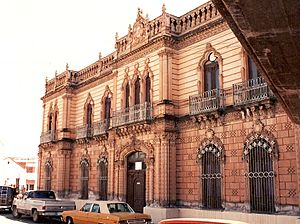Parral, Chihuahua facts for kids
Quick facts for kids
Parral, Chihuahua
|
||
|---|---|---|
| Hidalgo del Parral | ||
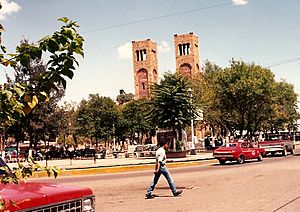
The Plaza Guillermo Baca in downtown Parral in 1992, showing the Searcher of Dreams Fountain and the Cathedral Shrine of Our Lady of Guadalupe, seat of the Diocese of Parral
|
||
|
||
| Country | ||
| State | Chihuahua | |
| Municipality | Hidalgo del Parral | |
| Founded | July 14 of 1631 | |
| Elevation | 1,620 m (5,310 ft) | |
| Population
(2015)
|
||
| • City | 109,510 | |
| • Metro | 129,688 | |
| Time zone | UTC-7 (MST) | |
| • Summer (DST) | UTC-6 (MDT) | |
| Postal Code |
31104
|
|
| Area code(s) | 627 | |
| Climate | BSk | |
Hidalgo del Parral is a city in the Mexican state of Chihuahua. It is also the main town of the Hidalgo del Parral municipality. The city is in the southern part of the state, about 220 kilometers (137 miles) from the state capital, Chihuahua, Chihuahua.
In 2015, Hidalgo del Parral had a population of 109,510 people. The larger metro area had about 129,688 residents. Long ago, during the time of Spanish rule, the city was a major source of silver for the Spanish Empire. It was known as San José del Parral. After Mexico became independent from Spain, the city's name changed. It was renamed to honor Fr Miguel Hidalgo, who is known as the 'Father of the Country'.
Contents
Geography and Landscape of Parral
Parral is built at the foot of a silver-rich hill called Cerro la Prieta. This hill is part of the Sierra Madre Occidental mountains. The rocks here are a mix of sedimentary and volcanic types. These rocks contain valuable lead and silver ores.
The city's landscape includes both its famous silver hill and nearby flat areas. These flat areas were perfect for growing crops like maize (corn) and for raising cattle. They also made it easier to travel to the state capital.
What is the Climate Like in Parral?
Parral has a semi-arid climate. This means it's usually dry, but it gets heavy thunderstorms during the hot summer months. From October to May, it's the dry season. Days can be warm to hot, and nights are cool. It often gets frosty in winter, but not for long periods.
| Climate data for Hidalgo del Parral (1951-2010) | |||||||||||||
|---|---|---|---|---|---|---|---|---|---|---|---|---|---|
| Month | Jan | Feb | Mar | Apr | May | Jun | Jul | Aug | Sep | Oct | Nov | Dec | Year |
| Record high °C (°F) | 32.0 (89.6) |
34.0 (93.2) |
38.0 (100.4) |
39.0 (102.2) |
41.6 (106.9) |
49.6 (121.3) |
42.5 (108.5) |
41.0 (105.8) |
40.4 (104.7) |
38.5 (101.3) |
35.4 (95.7) |
33.0 (91.4) |
49.6 (121.3) |
| Mean daily maximum °C (°F) | 18.4 (65.1) |
20.6 (69.1) |
24.2 (75.6) |
27.7 (81.9) |
31.1 (88.0) |
32.9 (91.2) |
30.5 (86.9) |
29.2 (84.6) |
27.8 (82.0) |
25.9 (78.6) |
22.5 (72.5) |
19.2 (66.6) |
25.8 (78.4) |
| Daily mean °C (°F) | 9.9 (49.8) |
11.9 (53.4) |
15.2 (59.4) |
18.8 (65.8) |
22.4 (72.3) |
24.9 (76.8) |
23.5 (74.3) |
22.4 (72.3) |
20.9 (69.6) |
17.8 (64.0) |
13.8 (56.8) |
10.7 (51.3) |
17.7 (63.9) |
| Mean daily minimum °C (°F) | 1.5 (34.7) |
3.2 (37.8) |
6.2 (43.2) |
9.8 (49.6) |
13.6 (56.5) |
16.9 (62.4) |
16.5 (61.7) |
15.7 (60.3) |
14.0 (57.2) |
9.8 (49.6) |
5.1 (41.2) |
2.1 (35.8) |
9.5 (49.1) |
| Record low °C (°F) | −15.0 (5.0) |
−22.0 (−7.6) |
−16.0 (3.2) |
−3.2 (26.2) |
2.0 (35.6) |
1.4 (34.5) |
4.0 (39.2) |
3.6 (38.5) |
2.0 (35.6) |
−4.0 (24.8) |
−8.0 (17.6) |
−10.2 (13.6) |
−22.0 (−7.6) |
| Average precipitation mm (inches) | 7.8 (0.31) |
5.6 (0.22) |
2.0 (0.08) |
8.2 (0.32) |
15.6 (0.61) |
56.7 (2.23) |
120.5 (4.74) |
117.3 (4.62) |
106.9 (4.21) |
24.9 (0.98) |
8.4 (0.33) |
5.6 (0.22) |
479.5 (18.88) |
| Average precipitation days (≥ 0.1 mm) | 1.7 | 1.4 | 0.6 | 1.4 | 2.8 | 7.0 | 12.8 | 13.0 | 9.4 | 3.8 | 1.8 | 1.7 | 57.4 |
| Average snowy days | 0.46 | 0.20 | 0.07 | 0 | 0 | 0 | 0 | 0 | 0 | 0 | 0.11 | 0.40 | 1.24 |
| Average relative humidity (%) | 57 | 54 | 50 | 46 | 44 | 53 | 63 | 65 | 67 | 61 | 61 | 61 | 57 |
| Mean monthly sunshine hours | 188 | 214 | 212 | 295 | 276 | 233 | 272 | 249 | 220 | 209 | 232 | 192 | 2,792 |
| Source 1: Servicio Meteorológico Nacional | |||||||||||||
| Source 2: Colegio de Postgraduados (snowy days) | |||||||||||||
The Rich History of Parral
Parral was once a very busy place for silver mining, especially during the 1500s and 1600s.
A story says that in 1629, a man named Juan Rangel de Biezma found silver on "Cerro la Prieta" (La Prieta Hill). He supposedly licked a rock and declared, "There is a mineral deposit here!" This mine produced silver for 340 years.
However, silver mines were already set up in Santa Barbara as early as 1567. Then, in 1631, a huge new silver discovery was made in what is now southern Chihuahua. By 1640, Philip IV of Spain even called Parral the "Capital of the World of Silver." This was during the peak of the Spanish Empire, which included lands in Asia, Italy, and the Netherlands.
How Parral Grew: Colonial Times
Parral's city plan during the Spanish colonial period was different from other towns. It didn't have a typical grid layout like a checkerboard. Instead, houses were built as close as possible to the mine and the hill. Over time, these simple homes became more permanent structures made of adobe (a type of mud brick). They often had small plots for growing vegetables.
The area around Parral also became important for farms and stock ranches. This was because the growing population needed a lot of food. The Spanish rulers made the region a permanent place for both mining and farming. This required a lot of food and workers.
Even though Parral's mines weren't the richest in northern Mexico, the town grew quickly. By 1640, Parral had 8,500 people. This made it the largest town north of the Tropic of Cancer in the Americas. It also had the largest group of enslaved African people living in one place during the colonial period.
Life and Work in the Silver Mines
Working in the silver mines was extremely difficult and dangerous. The main mine shaft at Cerro Prieta was 420 feet deep. Miners used picks, wedges, and crowbars to dig for metals. Their tools sometimes weighed up to forty pounds. Miners often worked for twelve hours or more each day.
Besides the hard physical labor, miners faced many dangers. They could fall into shafts or be crushed by collapsing parts of the mine. They also breathed in a lot of silica dust. This dust caused serious lung damage over time, leading to breathing problems and eventually death.
After the metals were dug out, workers, often enslaved Indigenous and African men, carried them to the surface. They used leather bags called tenatl (from an Indigenous word). These workers, called tenateros, carried bags weighing 225–300 pounds. They crawled through narrow tunnels and climbed up pine logs and ladders. Once at the surface, the ore was loaded into carts for transport.
The mines in Parral were part of a system called Reales de Minas in Northern Mexico. They had a strict, almost military-like, social structure. At first, it was hard to find workers for the Parral mines. The Chichimeca people, who lived in the area, were not used to staying in one place and resisted Spanish forced labor.
So, a system of free labor developed in Parral's mines. This attracted many workers from different Indigenous groups. These included Aztecs and Tarascan people from southern Mexico, and others from Sinaloa, Sonora, and Durango. This network of migrating mine workers and suppliers helped Parral's economy grow far beyond its borders.
After the metals were extracted, they were taken to many estates called haciendas for processing. Workers used a method called smelting. This involved crushing the ore and mixing it with molten lead to separate the silver from the rock. Some haciendas in Parral used a different method called patio amalgamation.
Parral After Independence
The large area of southern Chihuahua was home to the Rarámuri people. This area included the main road connecting the mining towns of Parral, Cusihuiriachic, and Chihuahua. The company Asarco managed the La Prieta mine until the silver boom ended in the early 1930s. The minerals were sent to the United States for final processing. Then, they were shipped back to Mexico, the US, and other countries. After the silver mining ended, Parral was almost completely empty in the early 1930s.
Today, Parral is a medium-sized city in Chihuahua. It is mainly focused on trade and business. It is an important center for trade between southern Chihuahua and northern Durango. Parral got its first local TV station in 1969, which was XHJMA-TV channel 3 (now closed). Currently, it has one local station, XHMH-TV channel 13.
Parral is also famous for its connection to several historical figures. These include Mexican revolutionary leader Pancho Villa, who was assassinated in Parral on July 20, 1923. He was first buried there. Another figure is "Dirty" Dave Rudabaugh, a well-known person from the Old West.
Visitors to Parral can explore the Palacio de Alvarado. This beautiful house from the late 1800s belonged to a wealthy mining owner. With a guide, you can also visit the mine itself. The city's winding streets and alleys give it a special colonial feel. The city's growth has been slow due to a lack of drinking water and its challenging landscape.
Exploring Notable Sites in Parral
Parral has many interesting historical places to visit.
El Palacio de Alvarado: A Grand Home
This palace belonged to one of Parral's most important families, the Alvarados. They owned the "La Palmilla" silver mine. The family was so rich they even offered to pay Mexico's national debt to President Porfirio Díaz. The palace was built by Federico Amérigo Rouvier. Today, it is a museum and cultural center. Many of its original European-made furnishings are still there. An Italian painter named Antonio Decanini painted the patio walls between 1946 and 1948.
El Hotel Hidalgo: A Gift to a Hero
This historic building was a gift from Don Pedro Alvarado to Pancho Villa. It is located right next to the Plaza Guillermo Baca.
La Casa de la Familia Griensen: A Brave Girl's Home
This is the birthplace of Elisa Griensen. She is famous in Parral's history for bravely standing up to U.S. soldiers. These soldiers were sent to capture Pancho Villa after he attacked Columbus, New Mexico.
The Francisco Villa Museum: Remembering a Leader
The Francisco Villa Museum is a historical building on the street where Villa's enemies waited for days to assassinate him in 1923. Every July, his death is reenacted here.
Casa Stallforth: A Beautiful Palace
This was a beautiful and luxurious palace with a stunning baroque style. Its facade is decorated with figures from Nordic mythology. It belonged to the Stallforth family. Along with the Alvarado family, the Stallforths were major helpers of the town, contributing a lot to its buildings and services.
Exciting Events in Parral
Parral hosts several unique events each year.
The Murder of Francisco Villa Reenactment
This is an annual event where people recreate the assassination of Francisco Villa. They use props from that time and perform it in the exact spot where it happened.
The Cabalgata Villista: A Horseback Journey
The annual Cabalgata Villista is a long horseback ride. Many people from across the state take part. It's an amazing sight as thousands of horses enter the city. This event is a type of Cavalcade.
Delicious Food of Parral
Parral is known for its rich history and its traditional foods. It was even named one of the "Ten Gastronomic Marvels of Mexico." This is mainly because of its artisan sweets called dulces de leche. These are a variety of candies and pastries made from old recipes using milk, sugar, and natural fruits. Other popular foods in Parral include enchiladas, rayadas, barbacoa, steaks, and cabrito (goat).
Dulces de Leche: Sweet Treats
Dulces de leche are milk-based candies found all over Mexico. However, Parral has been famous for its dulces de leche since the 1930s. They have a special flavor and often include nuts like pecans, peanuts, and hazelnuts. They also feature fruits such as apricot, pineapple, and coconut. Parral's candies have been sent all over the world, even to Vatican City, Washington D.C., and London!
These traditional sweets came to Parral in the early 1900s. No one knows exactly where the recipes came from, but it's thought they arrived in southern Mexico from Europe during colonial times. Then, these recipes were passed down through generations.
One of the most famous candy makers in Parral was Don Pablo Rodríguez. He founded "La Gota de Miel" (The Drop of Honey). Don Pablito, as people called him, was born in Jalisco in the late 1800s. He and his wife came to Parral in the early 1900s. Before that, they worked for several years as a baker and cook for Francisco Madero's parents in Coahuila. It's believed their recipes might have been influenced by other professional chefs working there.
In the late 1990s, some local candy makers in Parral tried to copy Don Pablito's original recipe, but they couldn't quite get it right.
Enchiladas: A Mexican Favorite
Enchiladas are a popular Mexican dish found across the country. Parral is traditionally known for its delicious enchiladas. They are made with a rolled corn tortilla filled with meat and covered in a tomato and chili sauce. Enchiladas can have many different fillings, like meat, cheese, beans, potatoes, vegetables, or seafood.
These food traditions in Parral began in the early 1900s and became very well-known by the mid-to-late 1900s. Enchiladas originated in Mexico. Old records suggest that the native people of the Valley of Mexico ate corn tortillas wrapped around small fish. The first Mexican cookbook, El cocinero mexicano (The Mexican Chef), published in 1831, mentioned enchiladas. It's likely that, like the dulces de leche, these recipes came to Parral from people who moved from southern Mexico.
Doña Cuca, who had a place near the historic Calicanto bridge, was one of the most famous enchilada cooks in Parral.
Barbacoa: Slow-Cooked Meat
Barbacoa is meat, usually from cattle or sheep, cooked slowly over an open fire. More traditionally, it's cooked in a hole dug in the ground and covered with maguey leaves. Today, it can also mean meat steamed until it's very tender.
In colonial and post-colonial times, Parral was famous for its tasty barbacoa or birria de hoyo. This barbacoa often included ingredients like bay leaf, garlic, maguey, and onions. It was a favorite food of important people, visitors, and miners working in Parral's silver mines.
Sports in Parral
Parral is home to some impressive sports achievements.
Judo: A Martial Art
Parral has one of the best Judo clubs in Latin America, called Judokan Parral. This Judo academy is in one of the more isolated parts of Mexico. One of its most famous students is Vanessa Zambotti. She is an Olympic judo-fighter with international experience. She won a gold medal at the XIX Central American and Caribbean Games and a silver medal at the Judo World Cup in 2008. Thanks to Judokan Parral, Judo in Parral is recognized at a Pan-American level.
Judo is becoming more and more important for young people in Northern Mexico who follow the sport. The story of Judo in Parral is being recorded through interviews and photos. This helps to show the impact of Judo on the people who practice it in this part of Mexico.
Baseball: The Mineros de Parral
Parral is well-known, especially in Northern Mexico, for its baseball team, Los Mineros de Parral (The Miners of Parral).
Famous People from Parral
Many notable individuals have connections to Parral:
- Gloria and Nellie Campobello: Ballet dancers and choreographers. They spent their childhood in Parral.
- Manuel Gómez Morín: A politician and a founder of the National Action Party.
- Juan Gómez-Quiñones: A historian, professor, poet, and activist.
- Linda Helú Atta: Mother of famous businessman Carlos Slim.
- Humberto Mariles: A show jumping champion who won gold medals at the 1948 Summer Olympics in London.
- Carlos Montemayor: A novelist, poet, essayist, and literary critic.
- Adrián Mora: A professional footballer.
- Antonio Ortiz Mena: A politician and economist who held important government positions.
- José Fernando Ramírez: A historian.
- Yair Rodríguez: A mixed martial artist and former Interim UFC Featherweight Champion.
- Misael Rodríguez: Won a bronze medal in boxing at the 2016 Summer Olympics.
- Rafael Rangel Sostmann: Former rector of the Instituto Tecnologico y de Estudios Superiores de Monterrey.
- Aurora Reyes Flores: A painter and the first female Mexican muralist.
- Alfredo Ripstein: A film producer.
- Jesús Gabriel Sandoval Chávez: A professional boxer.
- Vanessa Zambotti: A judoka who won a gold medal at the 2007 Pan American Games.
- Alex Dey: A motivational speaker.
- Eric Garcetti: Mayor of Los Angeles from 2012-2022.
Sister Cities
Parral has connections with other cities around the world:
 Santa Fe, New Mexico, United States
Santa Fe, New Mexico, United States West Kanpur, India
West Kanpur, India
See also
 In Spanish: Hidalgo del Parral para niños
In Spanish: Hidalgo del Parral para niños



